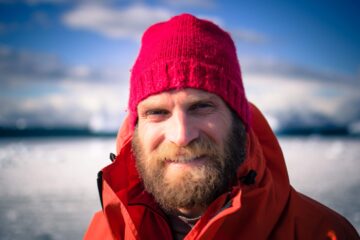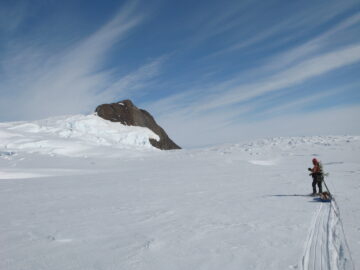ANTARCTIC BLOG: Extreme Geology #7
27 January, 2016 Marie byrd Land
Every person who works in Antarctica has a different experience and takes away different memories because our perception is shaped so much by our previous life experiences. The four of us here in Marie Byrd Land – scientists Steve Roberts and I, and our field guides Iain Rudkin (also known as Cheese) and Alistair Docherty – have worked, travelled and camped as a team for the past 5 weeks. Last night, we shared our memories of the trip so far, and share them here with you too – two here, and two to follow in the next few days. Enjoy!
Cheese:
“With our field season drawing to a close, I’m tasked with choosing my own personal highlight or stand-out moment. A single instance to remain long after the chronic flatulence and overwhelming body odour has receded. I’m reliably informed that my finding of a stray raisin of unknown vintage in my facial hair doesn’t fulfill this criteria (despite being particularly pleasurable and a good indication that I need to shave!). So I’m going for our initial sojourn over to Turtle Rock to establish a safe route to the work site and others near it.
Re-reading my earlier draft, littered with awe-inspiringly amazing adjectives and alliterations aplenty, it is apparent that my immature scribblings have utterly failed to convey the scene on that day, or indeed any of the emotions connected with the privilege of calling this place home for the last two months. A picture tells a thousand words, but a review of those also would leave the reader feeling similarly short-changed – in hindsight, it would have been easier to detail an account of the raisin discovery. After all, it wasn’t an inconsiderable raisin. Not oversize either, admittedly, but still sufficiently weighty as to astound me as to how I didn’t notice it. Maybe my beard was slightly matted with the previous day’s sun-cream providing increased purchase to my desiccated friend? Anyway, I digress…..
It’s been an experience-rich two months: plenty of tall tales of polar heroics to regale any potential grandchildren with, and that first unveiling of Turtle Rock – visual smorgasbord that it was – will reside in the upper echelons of those tales!
(In case you are wondering, I, of course, ate the raisin. If anything, the light soiling and unexpected joy at its discovery added to its succulence.)”

Jo:
“Yesterday Cheese and I attempted to get to Dorrel Rock, which lies surrounded by the fast-flowing ice of Pope Glacier. Our aim was to get to the top to collect erratic cobbles there. We knew the route would be challenging because it involved crossing the most crevasses terrain in the area. So I was really excited but also pretty nervous. For me, the trip would involve a few firsts: crossing the widest crevasses I have ever encountered close-up (15 metres), skiing with a pulk (a small sledge attached to one’s harness at the hips), and getting further south than I’ve ever been before. The ski in was awe-inspiring, with such dramatic scenery literally right under our feet, but walking the last bit was truly daunting because it seemed like there were crevasses everywhere we stepped… even though that particular section was the most benign-looking of the route we had planned using high-resolution satellite imagery.
After 5 hours, we were forced to turn back just 50 metres from the rock.
I could even see the precious erratics I had hoped to collect, we were that close. The feeling of defeat was frustrating and hugely disappointing for both me and Cheese. But it was also a poignant reminder that despite having modern technology – such as satellite imagery – at our disposal, the environment here continues to present insurmountable challenges.
As we walked out and skied home in somber mood, together we made a conscious effort to plant some good memories: we made sure to stop frequently to absorb our surroundings, and to take lots of photos. The day didn’t turn out as we had hoped, but it will nevertheless stay with me for a long time. I just feel so incredibly privileged to be here.”

In November 2015 geologist Joanne Johnson and 3 colleagues set off to work at one of the most remote parts of Antarctica to find out how the West Antarctic Ice Sheet has changed over the past 20,000 years.